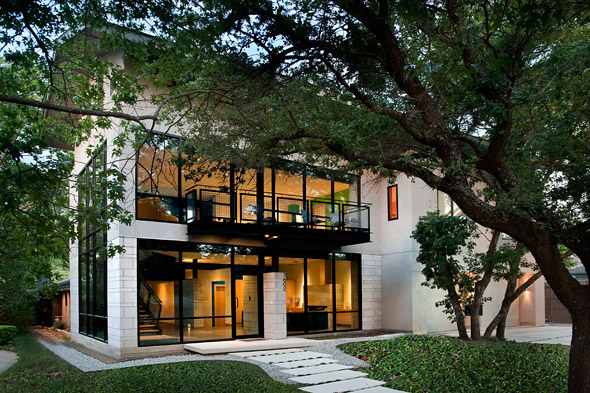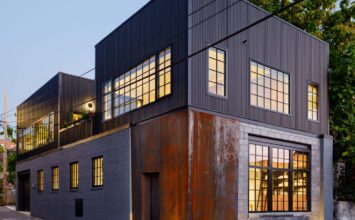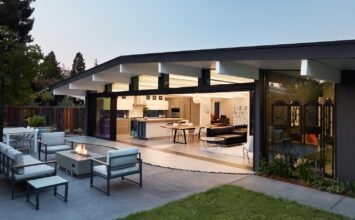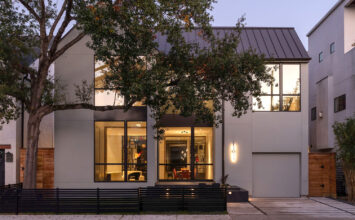
Among the homes to be featured on the upcoming Portland Modern Home Tour is ideahousePDX, the brainchild of designer-architect duo Holly Freres and David Horning.
David, a partner at MOA Architecture, and Holly, owner of JHL Design, Inc., set out to find a home to renovate for their family that expresses their lifestyle, aesthetic, sustainable building practices, and budget.
In less than a year and at less than $110 per square foot, David and Holly completed their dream home, which sits on an idyllic, ¾ acre lot and beautifully confirms their philosophy that simple materials, elegantly designed, can make an affordable dwelling.
We sat down with Holly, who walked us through the vision behind ideahousePDX, how couples can create a shared aesthetic, and how a high-low mix of materials can achieve that most sought-after balance – a budget-driven home that looks anything but.
Q&A w/ Holly Freres, JHL Design
You call your home ideahousePDX – an awesome name that suggests that the home is very concept-driven. What was your vision behind the home?
ideahousePDX was an experiment for David and myself. We were excited to do a project for ourselves; however, we had a very strict budget to work with if we were going to inhabit the home. As designers, we are constantly faced with the challenge of providing our clients with sustainable, efficient design. This often transfers into higher costs. We believe that there must be a way to have good design and energy efficient construction at an affordable cost. The concept behind ideahousePDX was to see if we could accomplish this goal – and thankfully, we did! We also wanted a modern house – which oftentimes comes with a high price-tag.

Using green materials and sustainable building practices is very important to both of you. How did you incorporate these into your home? For our audience at home looking to do the same, what are some of the simplest practices that yield benefits to the environment?
This was a really interesting part for us of the building process. We had a budget of $110/square foot, so we had to weigh the cost-benefit of each of the sustainable components. We looked into solar panels, stormwater retention, gray water retention, bio-swales, energy-efficient lighting, efficient mechanical systems, triple-pane windows and use of recycled materials. In the end, the sustainable practices that were most applicable to the property and the home were energy efficient lighting systems, bio-swale, air-sealing the exterior building envelope with spray foam insulation and using dense-packed cellulose in the walls. We also used a hydronic radiant floor heat system in the concrete floors throughout, which not only keep our gas bills low but give us a steady ambient and comfortable temperature even with the large expanses of glass.
To reduce heat loss and air infiltration, we opted for an un-vented attic assembly so the attic is part of our conditioned air space. With such a tight building envelope, we were able to use a heat recovery ventilator system. This not only allows us to reuse the heat from the exhausted air, but we can also continually introduce fresh air and improve air quality. We increased the roof insulation to R-45 from the required R-38, which helps retain steady temperature.
We did a lot of recycling since the existing foundation was in excellent condition. The slab was used with a small addition for the master bedroom. We recycled 75% of the house and donated it to the Rebuilding Center here in Portland where it was reused. We deconstructed the house by hand over a four-month period. We were able to mill down and reuse the house’s cedar ceiling and floors. The recycling of the house was not inexpensive, but it was very important for us to do.

You’ve put a lot of thought and care into the materials you chose, using a mix of high and low cost materials with a hint of luxury. Can you walk us through this high-low mix and how it plays out in your home?
Fortunately, we appreciate the raw nature of materials like plywood, steel and concrete – finished to expose their natural characteristics. We designed the kitchen to accommodate the pre-made Ikea cabinets and combined this with marble countertops and high-end drawer hardware. This gave the kitchen a very custom look. For the exterior, we wanted to play off of the traditional homes in the neighborhood, so we chose a fiber cement siding that mimicked the traditional cedar beveled siding, with a much smaller price tag. Even the color of the house was a nod to traditional homes in the area. We used remnants of materials where we could, like the wood slab countertop in the powder bathroom and we milled down the old cedar from the previous home and used it for ceiling treatments on the exterior and cladding for the front door.

You’ve achieved the ideal balance with your home — a budget-driven property that doesn’t look budget-driven. How did you accomplish this?!
We kept the materials palette really simple. David and I selected most of the interior finishes in one day. We designed inexpensive tile in a thoughtful pattern. We spent money on things that we knew we’d never want to change out – like the windows and doors. We laid out the tile in the kitchen so it highlighted the architecture. Basically, we spent a lot of time designing details around materials that were affordable. Reveals on the stairs, mill core detail around the windows and doors, recessed tile and vents and room layouts that were aesthetic to the surrounding property. All of this was important, but one of the largest savings was that we did a lot of the work ourselves. We general contracted the project and managed the contractors. We saved about 15% of our overall budget by doing this. It was a lot of work, but we knew that is what we had to do to make the numbers work and with our knowledge of the process, we knew we had the skills to do it.

How would you describe the culture of modern design in Portland? As an architect and designer, how would you say your tastes reflect the larger Portland design world?
Modern design in Portland is really all over the map. There is great mid-century design here, modern homes of the 80s (we used to live in a Dale Farr home that we loved!) and contemporary modern design. Modern architecture and design is gaining more and more popularity in Portland. I think people want a casual way to live and appreciate the outdoors, so living in an easy-to-maintain home that respects the environment and surroundings just fits with the values of Portlanders. David and I can’t escape this because that is how we like to live as well. We wanted a form that fit us and the landscape that surrounds us.

As a designer-architect couple, you both bring a unique eye and set of skills to the table. Did you find that you ever bumped heads in designing and building your home? What advice do you have for couples looking to create a shared aesthetic?
Wouldn’t this be a great place for a juicy story! Unfortunately, we don’t have one. We both have a pretty unique set of skills and we respect each other’s knowledge base. For example, we have a small interiors palette since we repeated a lot of materials. I took David to Pental, a local tile and slab store here in Portland, and I selected the materials for all of the bathrooms, kitchen and countertops in just a few hours. David wanted to research more but realized that I spend my days looking at materials and that I had vetted out what was in our budget and fit the house’s style. The same goes for the building envelope – David designed a layout that fit our family. He weighed what we needed and how we wanted to live. He was able to put all of the needs we have into a layout that suited us. We did a lot of late night walks through the house, analyzing details and making some changes along the way. As for couples looking to create a shared aesthetic, it is simply that – sharing a vision and really coming up with a design palette that suits you both is the key. We see what doesn’t work a lot with couples, so we knew what to avoid as far as collaboration goes. Hiring a professional to help can make the process smoother and a lot more fun, too. We know how to navigate the important details and address design needs of both parties in different aspects of the project.
Check out David and Holly’s ideahousePDX in person – grab you tickets to the Portland Modern Home Tour here!








